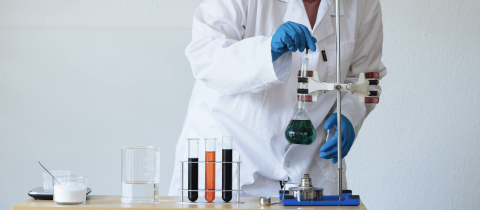A pretty morbid question perhaps, but why is it that our body does not decompose while we are alive? Most of the post-mortem changes that affect our body are the result of things we already carry inside of us, so how is it that these potent destructors are kept in check before we die?
Blood is a big part of the answer. Blood carries oxygen and glucose to our cells, and it transports waste products and carbon dioxide out. This ongoing exchange system keeps our body happy, but when we die our heart stops pumping blood around. Our cells are no longer receiving the oxygen they need to break down sugar into a usable energy source, and more importantly, the carbon dioxide produced by the cell has nowhere to go. Carbon dioxide is an acidic molecule, so the pH inside the cell starts to drop.
The inside of our cells is a little bit like Jurassic Park. Important areas are enclosed behind molecular fences called membranes. When the pH drops, some of these membranes rupture and release their content. As the famous 1993 movie taught us, when the electrified fences stop working, the dinosaurs escape. One particularly potent area inside the cell is called the lysosome. A small sac filled with dozens upon dozens of enzymes that thrive in its acidic environment, the lysosome is the stomach of the cell, and each cell has hundreds of them. When its membrane gets breached after death, its enzymes are free to roam around and start breaking down every part of the cell, digesting it from the inside out. This important component of decomposition is known as autolysis and it can be particularly swift in organs that are rich in lysosomes, like the pancreas, stomach and liver.
Autolysis means everything inside the cell gets broken down into small and smaller molecules by these native enzymes. Proteins, the purposefully shaped chains of amino acids our body depends on, are cut down into proteoses, peptones and polypeptides before these get digested into amino acids, which are further cut down into smaller products like putrescine and cadaverine. Our fats and carbohydrates are similarly digested, and our own DNA and RNA molecules get chopped down into their individual building blocks: sugars, phosphates, and nitrogenous bases.
Another fascinating result of our body no longer pushing blood around is the temporary phenomenon known as rigor mortis. When we are alive, our muscles can contract and relax. These actions take place because of calcium moving in and out of muscle cells, a pumping action that requires energy. When we die, this energy is no longer being produced. Calcium accumulates inside muscle cells. The two filaments that bind to and release each other inside our muscles become stuck in the bound position, as they too lack the energy required to let go of each other. This is rigor mortis or a stiffening of the muscles after death, and it only goes away when the free-roaming enzymes inside muscle cells get to these muscle filaments and start munching on them.
And then there’s the issue of our bacteria. Our body has roughly as many bacteria as it has cells, and many of these bacteria live in our large intestine where they further digest our food and are known to produce flatus. When we are alive, our immune system keeps them in check. But when this system stops functioning after death, bacteria begin to feast on the products of autolysis and, unopposed, they start to move around. This is a process known as putrefaction. As they feed on our tissues, these bacteria expel gases like methane and ammonia that create the bloating frequently seen in the abdomen after death. Over the course of hours, our bacteria spread to our spleen, liver, heart and brain.
All of these destructive processes arise simply because our body is a tightly regulated ecosystem that depends on the continuous cycling of oxygen, carbon dioxide, nutrients, and waste products. When the old ticker stops, the cycle ends and the whole system falls out of balance. It also exposes the body to the action of scavengers. Some of these critters are quite small, like insects, while others are the ones we purposefully brought into our homes. On a macabre note, a book on what happens to the body after death notes that “beloved, but hungry pets will bite the hand and face that no longer feeds them.” Something to keep in mind next time Fido or Kitty looks back and forth between you and their empty bowl.
Take-home message:
-Our body does not decompose while we are alive because blood flow keeps oxygen, carbon dioxide, nutrients, and waste products moving to where they need to go.
-When carbon dioxide accumulates inside a cell, it makes it more acidic, which leads to membranes breaking down, releasing enzymes that begin digesting the cell from the inside out.
-Our bacteria are normally kept in check by our immune system, but after death, they are free to roam around and digest our tissues, a process known as putrefaction.







